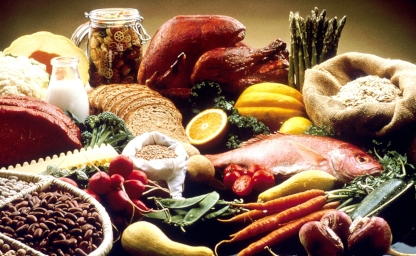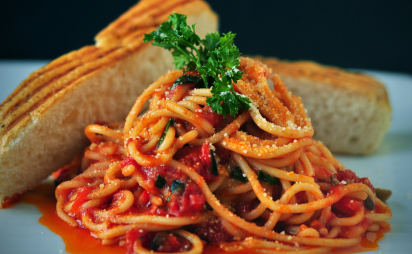
The article below is prepared by Anthony J. Cichoke and published
on the journal Better Nutrition, Sept, 2000. It differentiates food
allergies and intolerances and explains the successful treatment
of both conditions with digestive enzymes. Although old it still
as plenty of relevance.
Food Allergies
Often, when people experience an unpleasant reaction to something
they've eaten, they assume they have food allergies. Although approximately
40 percent of Americans believe they have food allergies, only about
1 to 3 percent of Americans actually suffer from food allergies.
What many believe is an allergy may simply be a food intolerance.
Fortunately, supplemental enzymes can help both conditions.
Food Allergies
A food allergy is an abnormal immune system response to a food
or food component. Normally, the immune system's job is to recognize
and expel foreign bodies such as viruses, bacteria, fungi and parasites.
In an allergic reaction to a food, however, the immune system mistakenly
recognizes normally harmless substances as foreign invaders. As
a result, the immune system produces an antibody called IgE (immunoglobulin
E, nicknamed the "allergy antibody"), which sets off a
chain of events to fight the allergen. This causes symptoms that
are collectively called an allergic reaction.
True food allergies can cause symptoms ranging from gastrointestinal
discomfort (including diarrhoea, stomach upset, indigestion, bloating,
gas, nausea, vomiting, and cramps), skin rashes, and tingling in
the mouth, to a devastating reaction marked by difficulty breathing
and even death. In fact, nearly 125 people die every year from an
allergic reaction to a particular food.
Only a handful of foods that produce allergies are responsible
for the majority of all allergic reactions. Usually, the protein
component of a particular food triggers an allergic reaction. Foods
responsible for the majority of all allergic reactions include:
milk, wheat, eggs, peanuts, tree nuts, soy, fish and shellfish.
Fruits such as strawberries and kiwis are also frequently implicated.
Food Intolerances
Although the immune system is involved in allergic reactions
to food, it is not responsible for the symptoms of food intolerance,
although the symptoms may be similar. A food intolerance usually
occurs because the body lacks the enzyme necessary to digest a specific
food.
How to tell the difference between a food allergy and
a food intolerance
Because the symptoms of a food allergy and a food intolerance
are often similar, it is difficult to determine the cause of particular
food reaction. Your physician, or other licensed health care practitioner,
however, can help diagnose a food allergy with tests. If you fail
all the allergy tests, than a food intolerance is probably to blame.
Your practitioner will ask for a complete history regarding your
reactions to various foods. S/he may then conduct tests including
skin pricking. In this test, the patient's skin is scratched or
punctured with a diluted extract of the suspected food and a reaction
indicates an allergy.
Blood tests such as a radioallergosorbent (RAST) test can measure
specific antibodies. The double-blind placebo-controlled food challenge
test is also used to test a person's reaction to a particular food.
This test involves giving the patient a capsule containing either
a sample of the allergen or a placebo. A double-blind test keeps
the patient's and the doctor's expectations from affecting the test
results. Unfortunately, this test will only confirm that the patient
reacts to a particular food, but won't differentiate between a food
allergy and a food intolerance.
Enzyme Therapy
Whatever the cause of your food reaction, enzymes can help. Enzyme
therapy is especially effective at fighting allergies because enzymes
can break down protein allergens and work to block the process that
causes an allergic reaction. Individuals with low pancreatic enzyme
output have an increased chance of suffering from food allergies.
Enzyme supplements can help augment the body's own pancreatic enzymes.
Therefore, the use of pancreatic enzymes has been suggested in the
treatment of food allergies.
One theory states that allergies are triggered by partially undigested
protein and that proteolytic enzymes decrease allergic symptoms.
Research tends to support this theory. So, supplementing with enzymes
can help prevent allergies.
Enzymes also stimulate immune activity and bolster immune system
function by promoting growth of healthy intestinal flora. Systemic
enzyme therapy is used to decrease inflammation, to improve circulation,
to break down and transport nutrients throughout the body, and to
remove waste products from the body. For food allergies, you should
consider taking a proteolytic enzyme (such as pancreatin) 1-to-1/2-hour
before or after a meal.
A note of caution: although enzymes can help allergies, individuals
suffering from severe food allergies should strictly avoid any food
to which they know they are allergic. To do otherwise may be life
threatening.
In the case of food intolerance, adverse reactions to foods can
often be eliminated when the proper enzyme is taken with the offending
food. Those who have problems digesting proteins should take a protease
(proteolytic) enzyme; for carbohydrates, take an amylase (amylolytic)
enzyme; for fats, take a lipase (lipolytic) enzyme. Taking lactase
tablets when consuming dairy products will help a lactose intolerant
person properly digest lactose, while taking alpha-galactosidase
will help someone who has trouble eating beans and other vegetables.
If you can't determine exactly what food component causes your
symptoms, try taking an enzyme combination that contains protease,
amylase, and lipase enzymes. Take them 30 minutes before a meal,
during meals or just after, depending on what works for you in digesting
food and reducing symptoms.
Conclusion
An unpleasant reaction to a food may not always be a sign of
a food allergy, it could indicate a food intolerance. Fortunately,
enzyme therapy can help to overcome both of these by enhancing immune
function and improving digestion.
REFERENCES
Altman, Daryl, M.D., Chiaramonte, Lawrence, M.D. "Public
perception of food allergy." Journal of Allergy and Clinical
Immunology 1247-1251, June, 1996.
Cichoke, Anthony J. The Complete Book of Enzyme Therapy Garden.
City Park, N.Y.: Avery Publishing Group, 1999.
Cichoke, Anthony J. Enzymes and Enzyme Therapy: How to Jump Start
Your Way to Lifelong Good Health. New Canaan, C.T.: Keats Publishing,
1994
Keller, R. Immunologie Und Immunopathologie (4th edition.) Stuttgart,
Germany: Thieme Verlag, 1994.
Klaschka, Franz. Oral Enzymes -- New Approach to Cancer Treatment.
Grafelfing, Germany: Forum Medizin, 1996.
McCann, M. "Pancreatic enzyme supplement for treatment of
multiple food allergies," Ann. Allerg. 71:269, 1993.
Metcalfe, Dean; Sampson, Hugh. Food Allergy: Adverse Reactions
to Foods and Food Additives (Second Edition). Cambridge, Mass.:
Blackwell Science, 1997.
Wrba, Heinrich & Pecher, Otto. Wirkstoffe Der Zukunft Mit
Der Enzymtherapie Das Immunsystem Starken. Vienna, Austria: Verlag
Orac, 1993.
Dr. Cichoke is an internationally known writer, lecturer and
researcher. He is the author of over 300 articles and 11 books including
The Complete Book of Enzyme Therapy; Enzymes and Enzyme Therapy:
How to Jump Start Your Way to Lifelong Good Health; Enzymes: Nature's
Energizers; and The Back Pain Bible. Watch for two new books coming
in 2000: FAQs: All About Enzymes and The Secrets of Native American
Herbal Formulas. Information on his books, nutrition and other topics,
as well as a bibliography on this article can be obtained by sending
a SASE to Dr. Anthony J. Cichoke, P.O. Box 92094, Portland, OR 97292-2094.

Food & Lactose Intolerance
Food intolerance is the inability to
completely break down food resulting in cramps, bloating,
wind, diarrhoea etc.
Lactose Intolerance
(milk) is the most common form and affects half the world
population. Food Allergy is not Lactose Intolerance. A guide
is provided.

Food & Milk Allergy
Food allergy is caused when the immune
system mistakenly responds to food proteins thinking they
are harmful substances. Symptoms include vomiting, itching,
rash, and hives. Allergies in children are very common,
but treatment with digestive enzymes may prove very helpful.

Coeliac or simply Wheat Sensitive?
In Coeliac Disease, gluten causes damage
to the small intestines, however, more people are wheat
sensitive. This shows negative in blood tests. Read how
to diagnose and avoid false negative screening results.

Baby Colic
Baby colic is very distressing to both the baby and the
parents. However, studies conclude that half the babies
suffer due to lactase deficiency. This is easily treated
by neutralising milk with lactase enzyme.

IBS or Simply Food Intolerance?
Medical studies confirmed 50% of patients diagnosed with
Irritable Bowel Syndrome may in fact be Lactose Intolerant.
Omitting dairy products from their diet, or treating it
with enzymes has helped them start a new life. Since IBS
symptoms are similar to LI, diagnosis can be confusing.

Carbohydrate Intolerance and Obesity
The inability to break down starch and other sugars leads
to bloating, wind, cramps, diarrhoea, etc. Now there is
evidence that obesity may be related to carbohydrate intolerance.
There is some good news with the help of digestive enzymes

Food Additives & E Numbers
The Romans used them, they come in 'numbers' or in weird
names. Some are healthy but others are 'bad' despite being
approved for consumption and depending where you live. Watch
out for the ones to avoid and the others not to worry about

Fructose Intolerance vs. Malabsorption
Fructose Intolerance is a rare genetical disorder and
leads to severe symptoms and may prove dangerous.
Fructose Malabsorption has symptoms similar to Lactose
Intolerance and avoidance of fruits helps.

Alcohol Allergy & Intolerance
Once ingested, alcohol is quickly broken down by enzymes
produced in the liver. Otherwise it is a toxin and the body
will react. Many people of oriental origin lack this enzyme
and this explains why they turn red when drinking alcohol.
So what is the cure?









